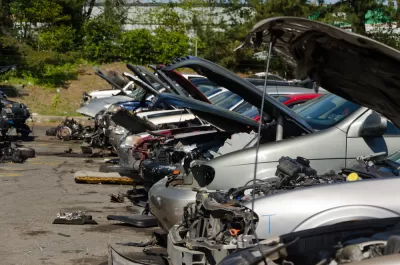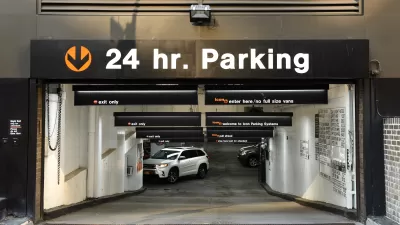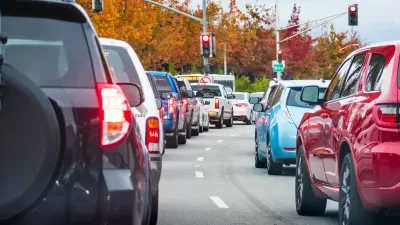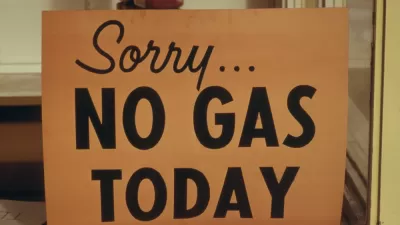A new paper makes a compelling case for three simple transportation policy changes that could significantly reducing emissions, congestion and accidents: distance-based vehicle insurance and sales taxes, and parking cash out.

Chicago StreetsBlog columnist new paper by transportation policy experts Allen Greenberg and John Evans, "Comparing Greenhouse Gas Reductions and Legal Implementation Possibilities for Pay-to-Save Transportation Price-shifting Strategies and EPA’s Clean Power Plan," makes a compelling case for reducing transportation emissions with three simple changes to driving incentives:
- Converting fixed pricing mechanisms for car insurance to pay-as-drive-and-you-save (PAYDAYS), which charge people a variable rate, based upon how many miles they drive;
- Requiring employers who provide free parking for their employees to implement parking cash-out programs, which provides an equivalent cash incentive to employees who do not drive alone to work; and
- Converting fixed-percentage sales taxes on new vehicle purchases to mileage-based taxes spread over a three-year period.
These changing could provide substantial benefits, achieving between 37 percent and 95 percent of the emissions reductions projected from the Obama administration’s Clean Power Plan, the authors estimate. These are win-win strategies: In addition to reducing pollution emissions they also provide substantial consumer savings, public health and safety benefits, and congestion reductions, plus road and parking facility cost savings. Because PAYDAYS insurance pricing gives higher-risk drivers an extra incentive to reduce their mileage, each 1% reduction in vehicle mileage should provide a greater than 1% reduction in crash casualties.
We know the Trump administration doesn’t care about global warming and is outright hostile to any attempts to address it. So Greenberg and Evans say states should pick up the slack. As air quality researcher Tim Kovach explains:
"They found that if each of the 19 states (plus the District of Columbia) that voted for Hillary Clinton in 2016 signed up for these three ideas, it would cut GHG emissions by 103 MMTCO2e (40% of total potential savings). Next, they estimated that if California, the nine East Coast states in the Regional Greenhouse Gas Initiative (RGGI), and the eight other states that signed up to defend the CPP in federal court all took action, they could achieve 35% of the emissions savings from the CPP."
Kovach concludes,
"As this paper makes clear, policymakers at all levels of government can put a real dent into transportation-related GHGs by implementing smart transportation demand management (TDM) policies. But beyond just tackling, you know, an existential planetary crisis, these types of TDM policies create co-benefits. Internalizing the real costs of driving and reducing VMT will reduce traffic crashes, potentially averting thousands of injuries and premature deaths, cut car insurance premiums, improve air quality, lessen the strain on infrastructure, increase sales of more fuel efficient/alternative fuel cars for automakers, curb economic inequality, and begin to shift us away from the myriad costs of our SOV-centric transportation system."
FULL STORY: 3 Policy Fixes That Could Dramatically Reduce Transportation Emissions

Alabama: Trump Terminates Settlements for Black Communities Harmed By Raw Sewage
Trump deemed the landmark civil rights agreement “illegal DEI and environmental justice policy.”

Planetizen Federal Action Tracker
A weekly monitor of how Trump’s orders and actions are impacting planners and planning in America.

The 120 Year Old Tiny Home Villages That Sheltered San Francisco’s Earthquake Refugees
More than a century ago, San Francisco mobilized to house thousands of residents displaced by the 1906 earthquake. Could their strategy offer a model for the present?

BLM To Rescind Public Lands Rule
The change will downgrade conservation, once again putting federal land at risk for mining and other extractive uses.

Indy Neighborhood Group Builds Temporary Multi-Use Path
Community members, aided in part by funding from the city, repurposed a vehicle lane to create a protected bike and pedestrian path for the summer season.

Congestion Pricing Drops Holland Tunnel Delays by 65 Percent
New York City’s contentious tolling program has yielded improved traffic and roughly $100 million in revenue for the MTA.
Urban Design for Planners 1: Software Tools
This six-course series explores essential urban design concepts using open source software and equips planners with the tools they need to participate fully in the urban design process.
Planning for Universal Design
Learn the tools for implementing Universal Design in planning regulations.
Clanton & Associates, Inc.
Jessamine County Fiscal Court
Institute for Housing and Urban Development Studies (IHS)
City of Grandview
Harvard GSD Executive Education
Toledo-Lucas County Plan Commissions
Salt Lake City
NYU Wagner Graduate School of Public Service





























